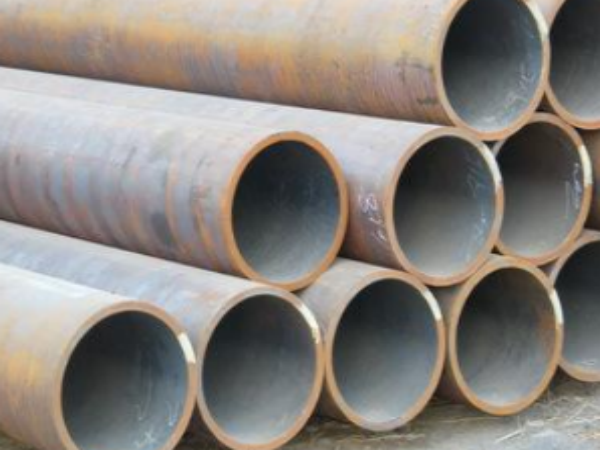The
seamless steel pipe bears 20% more pressure than the welded steel pipe, and its strength is very high. And because there are no seams, it is more resistant to corrosion.
1. The production process of seamless steel pipe can be divided into cold drawing and hot rolling. The production process of cold rolling seamless steel pipe is generally more complicated than hot rolling. Sizing test, if the surface does not respond to cracks, the round pipe will be cut by a cutting machine, and cut into a billet with a length of about one meter.
2. Enter the annealing process. Annealing should be pickled with acidic liquid. When pickling, pay attention to whether there is a large amount of foaming on the surface. If there is a large amount of foaming, it means that the quality of the steel pipe cannot meet the corresponding standards.
3. The delivery state of hot-rolled seamless steel pipes is generally delivered after heat treatment in the hot-rolled state. After passing the quality inspection, the hot-rolled seamless steel pipe must be strictly hand-selected by the staff. After the quality inspection, the surface must be oiled, followed by multiple cold-drawing experiments, and the perforation experiment must be carried out after the hot-rolling treatment. , If the perforation diameter is too large, it will be straightened and corrected.

4. The outer diameter of hot-rolled seamless pipe is generally greater than 32mm, and the wall thickness is 2.5-200mm. The outer diameter of cold-rolled seamless steel pipe can reach 6mm, and the wall thickness can reach 0.25mm. The outer diameter of thin-walled pipe can reach 5mm, and the wall thickness is less than 0.25mm. , Cold rolling has higher dimensional accuracy than hot rolling.
5. Generally used seamless steel pipes are made of high-quality carbon steel such as 10, 20, 30, 35, 45, 16Mn, 5MnV and other low-alloy structural steels or 40Cr, 30CrMnSi, 45Mn2, 40MnB and other combined steels that are hot-rolled or cold-rolled. of. 10, 20 and other low carbon steel seamless pipes are mainly used for fluid conveying pipelines.
6. There are three ways to connect the pipe thread: cylindrical internal thread inserted into cylindrical external thread, cylindrical internal thread inserted into conical external thread, and conical internal thread inserted into conical external thread. Among them, the connection of the latter two methods is relatively close and is a common connection method.
(1) Flanged flange connection. Flanged loose sleeve flanges are generally used for pipes of similar materials such as copper pipes, lead pipes, and plastic pipes. When flanging, different operating methods are selected according to different materials. The flanging is required to be flat, without cracks and wrinkles.
(2) Threaded flange connection, using flanges with internal threads to connect with steel pipes with external threads. This flange is mostly made of cast iron and can be used for the connection of low-pressure pipelines.
(3) Welding flange connection, flange and steel pipe are connected by welding, this kind of flange connection is widely used. The welding method is as follows: select a pair of flanges and install them on the two connected pipe ends respectively. If some equipment has flanges, choose flanges of the same specification and place them on the spot welding point first. Correct the verticality, and finally weld the flange and the pipe firmly.
What are the connection methods of seamless steel pipes?
1. Compression type: Insert the pipe into the nozzle of the pipe fitting, fasten it with a nut, and use the screw force to compress the sleeve at the nozzle through the sealing ring, which acts as a seal and completes the connection of the pipe.
2. Welding type: The end of the pipe is processed with a bevel, and the pipe is welded circularly by manual or automatic welding.
3. Flange type: The flange and the pipe are welded by circular argon arc welding, and fastened with quick clamps or bolts, so that the gasket between the flanges acts as a seal to complete the pipe connection.
4. Compression type: Insert the pipe into the pipe fitting and use a special installation tool to press the pipe wall into a hexagonal shape, and the internal sealing ring is also deformed into a hexagonal shape
5. Tapered thread type: the outer thread and the pipe are welded in a ring shape, and the inner threaded pipe fittings are sealed by the tapered thread connection to complete the pipe connection.
In terms of manufacturing process, seamless steel pipes can be divided into hot-rolled and cold-drawn seamless steel pipes.
Hot-rolled seamless steel pipe: heat the round tube billet to a certain temperature first, then perforate it, then go to continuous rolling or extrusion, then go to stripping and sizing, then cool down to the billet tube and straightening, and finally It is to carry out procedures such as flaw detection experiments, marking, and warehousing.
Cold-drawn seamless steel pipe: heating, piercing, heading, annealing, pickling, oiling, cold rolling, blank pipe, heat treatment, straightening, flaw detection and other procedures for the round tube blank.













 Eastern Steel Manufacturing Co.,Ltd not only improve product production and sales services, but also provide additional value-added services. As long as you need, we can complete your specific needs together.
Eastern Steel Manufacturing Co.,Ltd not only improve product production and sales services, but also provide additional value-added services. As long as you need, we can complete your specific needs together.










